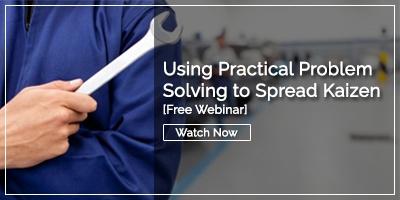Kaizen events are intensive, short-term improvement initiatives that bring teams together to solve specific problems within 3-5 days. These structured workshops combine Lean Six Sigma methodologies with focused collaboration to deliver rapid, measurable improvements while building organizational capabilities and fostering a culture of continuous improvement.
What are the Benefits of Kaizen Events?
If you've ever been frustrated by problems that just keep dragging on, Kaizen events might be exactly what you need. Here's what makes them worth your time:
They Actually Get People Working Together
-
Breaking down silos: Most problems happen when work moves between departments, so you need those departments talking to each other
-
Better communication: When people have to solve something together in a few days, they get really good at listening and explaining things clearly
-
Leadership practice: Someone's got to run the show, and these events give people a chance to step up and lead
Everyone Learns Something New
-
Hands-on training: Instead of sitting through another PowerPoint presentation, people learn by doing real work on real problems
-
Tool introduction: Perfect time to teach new team members about improvement tools like root cause analysis or process mapping
-
Building knowledge: When you document what you learn, the next team doesn't have to start from scratch
You Find More Than What You're Looking For
-
Hidden problems surface: Start looking at one issue, and you'll probably spot three more that need attention
-
Culture shift: When people see that improvement actually works, they start suggesting more ideas
-
Better future events: Each event teaches you how to run the next one even better
What Goes Into Planning a Kaizen Event?
You can't just throw people in a room and hope for the best. Here's what you need to figure out beforehand:
|
What You Need to Define |
What This Looks Like |
Why It Matters |
|
The Problem |
"Customers wait too long for order processing" not "things are slow" |
If you can't describe it clearly, you can't fix it |
|
Process owner, executive sponsor, facilitator, people who actually do the work |
You need both decision-makers and people who know what really happens |
|
|
Additional Team Members |
Subject experts, maybe some customers, anyone else who gets affected |
Keep it to 6-8 people total or it gets chaotic |
|
Scope of Project |
Clear lines about the process to be improved and the boundaries for the event |
Scope creep kills these events |
|
When and Where |
3-5 days, specific times, where you'll meet |
People need to block their calendars completely |
|
Success Looks Like |
"Reduce processing time from 4 hours to 2 hours" |
Vague goals get vague results |
|
What You Need |
Budget, tools, people's time, access to systems |
Nothing worse than getting stuck because you can't access something |
|
What Could Go Wrong |
"The IT system might be down" or "Bob might be traveling" |
Think about problems before they happen |
|
Daily Plan |
What you'll accomplish each day |
Keep everyone focused and moving forward |
How Do You Actually Run a Kaizen Event?
Every Kaizen event is different, but here's the basic flow that usually works:
Days 1-2: Map the current state and document the desired state
Before any improvements can be enjoyed, it is necessary to understand and document the current state of the process thoroughly.
-
Map the current process: Draw out exactly how things work now (not how they're supposed to work)
-
Listen to customers: What do they actually experience? What frustrates them?
-
Find the real problems: Where do things break down or slow down?
-
Agree on the target: What does good look like, and how will you measure it?
Days 2-3: Consider solutions and agree on improvements to implement
During this phase, the team facilitator should ensure that everyone is heard and encourage all participants to think creatively. Everyone in the group must be ready to accept new ideas and different perspectives. It may take some time to agree on what steps to take, and that's OK.
-
Get to the root cause: Don't just fix symptoms - figure out why the problem exists
-
Brainstorm ideas: Everyone gets to contribute, no idea is too crazy at first
-
Pick what to try: Choose solutions you can actually implement and test
-
Get approval: Make sure the boss is on board and you have what you need
Days 3-4: Implement improvements
Once the team has decided what changes to implement and secured the necessary resources, it's time to get moving.
-
Put changes in place: Actually do the work, don't just talk about it
-
Train people: Show everyone affected how the new process works
-
Test it out: Does it actually work the way you thought it would?
-
Adjust as needed: Fix anything that's not working quite right
Days 4-5: Measure results and develop new Standard Work
After the improvements are implemented, there should be time to observe and possibly refine them before the process changes are considered final.
-
Measure the results: Did you actually improve what you set out to improve?
-
Write it down: Document the new process so it doesn't drift back to the old way
-
Share the news: Tell people what you accomplished
-
Capture lessons: What would you do differently next time?

When Does a Kaizen Event Make Sense?
You've got options for improvement - daily small changes, longer projects, or these intensive events. Here's when the event approach works best:
Go With a Kaizen Event When:
-
Something's broken and needs fixing now (quality problems, angry customers, failed audits)
-
The impact could be huge for your key metrics or business goals
-
Different departments need to work together to solve it
-
Your regular improvement efforts aren't working on this particular problem
-
You can reasonably expect to fix it in a week (not too simple, not impossibly complex)
-
Your team needs practice working together and solving problems
-
You have new people who need to learn how improvement works around here
Stick With Daily Improvement For:
-
Small problems that don't need a whole team
-
Keeping improvements from sliding backward
-
Building good habits over time
-
Issues that one person or department can handle
How Do You Make Sure Kaizen Events Actually Work?
Before You Start
-
Get your charter right: Spend time upfront getting clear on what you're doing and why
-
Pick the right people: You need folks who know the work and people who can make decisions
-
Line up your resources: Nothing kills momentum like not having what you need
-
Make sure leadership cares: If the boss doesn't support it, neither will anyone else
While You're In It
-
Keep a good facilitator: Someone needs to keep things moving and make sure everyone gets heard
-
Stay focused: It's tempting to fix everything, but stick to your scope
-
Include everyone: Make sure the quiet people get to share their ideas too
-
Keep people posted: Let stakeholders know how it's going
After It's Over
-
Check back regularly: Look at your results after 30, 60, and 90 days
-
Share your success: Let other teams know what you accomplished
-
Document what you learned: Help the next team do even better
-
Plan your next move: What else needs attention?
Frequently Asked Questions About Kaizen Events
How long should these things take?
Most teams find 3-5 days works best. Any shorter and you don't have time to really understand the problem. Any longer and people lose focus and momentum.
How many people should be involved?
Keep it to 6-8 people max. You need the key players (someone who knows the process, someone who can make decisions, someone to facilitate) plus a few others who bring different perspectives.
Can you do this remotely?
Absolutely. Remote events can work great if you have good facilitation, the right technology, and everyone's actually committed to participating (not multitasking).
What's the difference between this and just improving things day-to-day?
Daily improvement is about small, ongoing tweaks that individuals or small teams make. Kaizen events are for bigger problems that need focused attention and cross-functional collaboration.
How do you know if it was worth it?
Look at both the numbers (did you hit your improvement targets?) and the softer metrics (did people learn new skills, are they more engaged in improvement?). Check back a few months later to make sure the improvements stuck.
What if it doesn't work?
Not every event will hit all its goals, and that's okay. You'll still learn something valuable. Figure out what got in the way (was the problem too complex? Did you have the right people? Enough resources?) and use that knowledge for next time.




Add a Comment